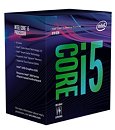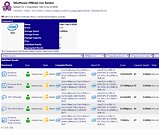Tuesday, January 16th 2018

Intel Core i5-8500 Surfaces on SANDRA Database
It's no revelation that Intel is expanding its 8th generation Core "Coffee Lake" desktop processor lineup through Q1-2018, alongside cost-effective B360 Express and H310 Express motherboard chipsets. One of these is the Core i5-8500 six-core processor, positioned a notch above the current Core i5-8400. The chip surfaced on a SiSoft SANDRA database entry. Although the i5-8400 launched at $189, retailers are pushing it for 10-15 percent margins above MSRP. The i5-8500 could launch bang-on the $200-mark, although one must expect a similarly jacked up $220-ish retail price.
The Core i5-8500 comes with a psychologically-pleasing 3.00 GHz nominal clock speed (while the i5-8400 has a sub-3 GHz clock of 2.80 GHz). The database entry doesn't reveal Turbo Boost clocks, but given that the i5-8400 comes with a 4.00 GHz Boost frequency, one can expect that of the i5-8500 to be 4.20-4.30 GHz. The 6-core/6-thread chip comes with 9 MB of shared L3 cache, and a TDP rating of 65W. It scored 139.63 GOPS in the Arithmetic test, 317.88 Mpix/s in the multi-media test, 7.49 GB/s in the cryptography test, which puts its performance in the league of AMD's Ryzen 5 1600.
Source:
SANDRA Database
The Core i5-8500 comes with a psychologically-pleasing 3.00 GHz nominal clock speed (while the i5-8400 has a sub-3 GHz clock of 2.80 GHz). The database entry doesn't reveal Turbo Boost clocks, but given that the i5-8400 comes with a 4.00 GHz Boost frequency, one can expect that of the i5-8500 to be 4.20-4.30 GHz. The 6-core/6-thread chip comes with 9 MB of shared L3 cache, and a TDP rating of 65W. It scored 139.63 GOPS in the Arithmetic test, 317.88 Mpix/s in the multi-media test, 7.49 GB/s in the cryptography test, which puts its performance in the league of AMD's Ryzen 5 1600.


19 Comments on Intel Core i5-8500 Surfaces on SANDRA Database
An 8400 usually runs at 3.8Ghz all cores while in mild stress test, so this should do it at 4.0Ghz.
Kinda hard to get those at their MSRP in NA right now... that sucks. These are really good chips.
Does this come in a K variant?
Its the usual for everyone in this segment
It only makes sense to make a "K" version of the top CPU in the segment.
Kaby Lake: 7350K, 7600K and 7700K.
Coffee Lake: 8350K, 8600K and 8700K.
Everything else is locked.
The first phase of sales was all about the OC-friendly Z370, so they focused on selling i5s as the top 8600K specification. Now the cheaper chipsets are coming, so they're populating the lineup.
Stable clocks > 4 GHz are already difficult to achieve and pushing further makes hardly any sense. It's not the direction CPU development has chosen.
It's much better to improve the instruction set (e.g. with AVX-512) and efficiency.
An architecture designed for 4GHz+ would lose so much power efficiency that it would be useful only in desktops - forcing manufacturers to seperate it from laptops and servers. And you don't want that. :)
For the 1600X vs. 1600, at least you can tell a difference in bechmarks, price...OC'ing and lack of included cooler.
Coffe lake, with the 8500, has 7 skus. Ryzen has 9. I guess i just dont understand what you mean considering their lineups.
Edit: coffe lake literally has an unlocked processor with higher speeds and no cooler as well as locked variants at lower clocks with a cooler for notably lower pricing for each segment (6/12, 6/6, and 4/4).And i just answered with the 'k' variant of that cpu. Yes, its faster, but its the unlocked version of that cpu, no? Also i meant 8600k as it is 6c/6t. :)
Intel has a dense product lineup, but these CPUs are locked. So in a way you're paying for performance: i5-7500 is 10% more expensive than i5-7400 and it performs ~10% better.
On the top of each segment (i3, i5, i7) you have an overclockable K variant, which extends the performance range.
It makes a lot of sense and is also Intel's way of improving yields.
The interesting part in Coffee Lake launch is that we only got i5-8600K and i5-8400 in the first wave. This could mean that the quality variance is very low, i.e. a lot of CL i5s meet the quality threshold of 8600K.
I meant to share my opinion on Intel creating SKUs with minimal performance difference (200Mhz apart) and little gap in cash ($10 - MSRP) while AMD, with Ryzen, there being a higher gap between the 1500X and the 1600 (a pair of cores and $30), the 1600 and the 1600X (400MHz, 30W TDP/OC headroom, $30)...you know, actually making a market segment and influencing your purchase choice.
Now, AMD's approach makes sense to me and is different from Intel. During the Phenom II days it was awful, models just 100MHz apart and prices all over the place.
I mean, if you paid more, you could barely see the difference. I believe it is the same case here, where you can tell a 8400 from a 8600K, but not between 8400 and 8500, except that you spent $10 more on the 8500.
If this is irrelevant for you, I guess we have different ways of dealing with the market :ohwell:
Edited to one-up the grammar.
Again, look at the Coffee Lake lineup. There are 6 CPUs with this 8500 being 7. There is a locked and unlocked version without and with heatsinks for each core/thread tier. Price difference is ~$50 between them. The 8700K and 8700 are not much different clocks wise, yes. But with them, like all of them, you are paying for a premium of higher base and boost clockspeeds, and an unlocked multiplier. Seems simple enough to me, honestly. :)
And if you look at AMD's... they have 15 total for four different core/thread setups. If you knock it back to three, they have 10 in the same space. Take the Pros out and they have 6 in the same space as well....though they are missing a 6/6 option that Intel has while intel is missing 4/8.